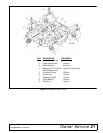
Operation 17
5WPMAN0862 (11/11/2010)
When engaging the PTO, engine rpm should always be
low. Once engaged and ready for mowing, increase
PTO speed to 540 rpm and maintain speed throughout
the cutting operation.
Mower vibration tends to loosen bolts. All hardware
should be checked regularly to maintain proper torque.
Each time the mower is used, check all hardware to be
sure it is secure. Recommended torque values can be
found on page 61.
The condition of the terrain will determine cutting
results. For best results, mower blades should be kept
sharp at all times and the platform as level as possible.
When mower blades show excessive wear, they
should be replaced.
Operating Technique
Stop power unit and implement immediately
upon striking an obstruction. Dismount power unit,
using proper procedure. Inspect and repair any
damage before resuming operation.
Proper ground speed will depend upon the terrain, the
height, type, and density of material to be cut.
Normally, ground speed will range from two to five
mph. Tall dense material should be cut at a low speed;
thin medium-height material can be cut at a faster
ground speed.
Always operate tractor PTO at 540 rpm to maintain
proper blade speed and produce a clean cut.
Under certain conditions, tractor tires may roll some
grass down and prevent it from being cut at the same
height as the surrounding area. When this occurs,
reduce your ground speed, but maintain PTO at 540
rpm. The lower ground speed will permit grass to par-
tially rebound.
In general, lower cutting heights give a more even cut
with less tendency to leave tire tracks. However, it is
better to cut grass frequently rather than too short.
Short grass deteriorates rapidly in hot weather and
invites weed growth during growing seasons. Follow
local recommendations for the suitable cutting height in
your area.
Operating Tips
Inspect and clear area of stones, branches, or
other hard objects that might be thrown, causing
injury or damage.
Extremely tall material should be cut twice. Set mower
at a higher cutting height for the first pass. Then cut at
desired height 90 degrees to the first pass.
Remember, sharp blades produce cleaner cuts and
require less power.
Analyze area to be cut to determine the best proce-
dure. Consider height and type of grass and terrain
type: hilly, level, or rough.
Uneven Terrain
Do not operate or transport on steep slopes.
Do not stop, start, or change directions sud-
denly on slopes.
Use extreme care and reduce ground speed on
slopes and rough terrain.
Watch for hidden hazards on the terrain during
operation.
In extremely uneven terrain, rear wheel weights, front
tractor weights and/or front tire ballast should be used
to improve stability.
Pass diagonally through sharp dips and avoid sharp
drops to prevent “hanging up” the tractor and the
mower. Practice will improve your skills in maneuvering
rough terrain.
Avoid sudden starts and stops when traveling up or
down hill.
Always mow down slopes, never up or across the face.
Avoid operating on steep slopes.
Slow down on sharp turns and slopes to prevent tip-
ping and losing control.
REMOVING MOWER FROM TRACTOR
1. Park the unit on a level, hard surface with the
wings and rear deck fully lowered to the ground.
2. Block the wheels to keep the mower from rolling
when unhitched from tractor.
3. Attach the jack to the side of the tongue and adjust
the height to take the weight off the tractor hitch.
4. Disconnect the PTO shaft and the hydraulic hose,
untie the mower transport lock release rope from
the tractor, and remove the hitch pin.
5. Store the PTO shaft end and the hydraulic hose
couplings off the ground and keep them clean.
CAUTION


















